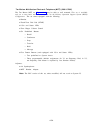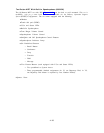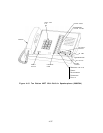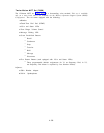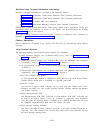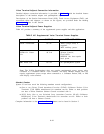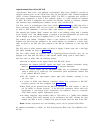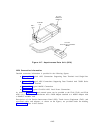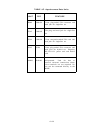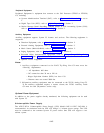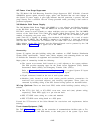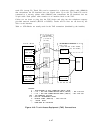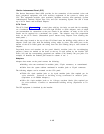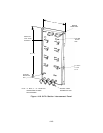Asynchronous Data Units (AD US)
Asynchronous Data Units, and Multiple Asynchronous Data Units (MADUs), provide an
interface between ports on the TN726 Data Line CP and RS-232C Data Terminal Equipment
(DTE) or Data Communications Equipment (DCE). The DTE is equipment that provides a
data source, termination, or both—a host computer, printer, or a data terminal are examples
of DTE. The DCE is equipment that provides the functions required to establish, maintain,
and terminate data communications—modems are the most common DCE.
The Z3A series of Asynchronous Data Units (ADUs) (Figure 4-17) are DCE that allow a
direct connection between DTE and port circuits on the Data Line CP (TN726). To connect
an ADU to DCE equipment, a cross-over cable (“null modem”) is required.
The modular jack labeled “Wall” connects the ADU to the building wiring with a standard
4-pair modular cord.
The 400B2 Adapter is required to provide supplemental AC power and
can be bridged at the wall jack if required (Z3A1, 2, and 4 units only).
The modular jack labeled “Telephone” allows a voice terminal to be attached to the ADU.
Separate wire pairs from the telephone to the system cabinets are provided in a single 4-pair
cable run back to the SIP. The pairs separate at the SIP for connection to voice and data
ports.
The Z3A series of ADUs measure about 4.5 inches in length, 2 inches wide, and 1 inch high.
The ADUs available are shown in Table 4-F.
The Z3A ADUs should be installed only on lightning-protected facilities; they are not
designed to be used with CO cables or with exposed outside wiring (such as aerial cables).
The Z3A series of ADUs offer the following features:
● Provide an interface to the digital switch from RS-232C device.
● Increases the distance RS-232C signals can travel over standard twisted-pair wiring.
Refer to Section 5, “Technical Specification” for distance limitations.
● Data and control signals can be transmitted 2,000 feet in asynchronous full-duplex
mode at speeds up to 19,200 bps. The transmission speed automatically matches that
of the attached RS-232C device.
● The DC isolation via opto-couplers ensures high noise immunity, resulting in very
low error rates.
● A variety of Z3AS with different connectors allows easy connection to RS-232C
terminals, printers, and host computers (see Table 4-F).
● Most Z3AS can be powered from the RS-232C interface. The ADU requires 7 volts on
pin 20 (DTR) to operate properly. If the RS-232C equipment cannot meet this
requirement, a low-voltage power transformer and adapter(s) must be connected.
Z3A5 ADUs
always require supplemental power.
● An analog single-line voice terminal (2500 or 7100 series) or a 7300H series multiline
voice terminal (Z3A5 ADU required) can be connected to the ADU, allowing the voice
terminal and DTE to share a common wall jack and 4-pair cable run back to the SIP.
Note: Neither off-premises nor out-of-building service can be provided with ADUs.
For additional information on ADUs, see Z3A
Asynchronous Data Unit User Manual (555-
401-701).
4-42



